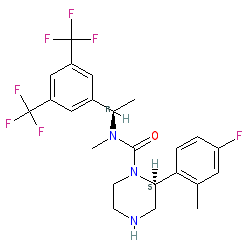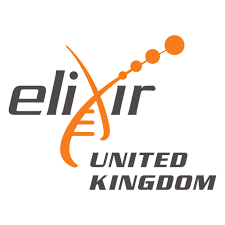|
Synonyms: GW597588B
Compound class:
Synthetic organic
Comment: Vestipitant is an investigational NK1 receptor antagonist.
Ligand Activity Visualisation ChartsThese are box plot that provide a unique visualisation, summarising all the activity data for a ligand taken from ChEMBL and GtoPdb across multiple targets and species. Click on a plot to see the median, interquartile range, low and high data points. A value of zero indicates that no data are available. A separate chart is created for each target, and where possible the algorithm tries to merge ChEMBL and GtoPdb targets by matching them on name and UniProt accession, for each available species. However, please note that inconsistency in naming of targets may lead to data for the same target being reported across multiple charts. ✖ |
|
|||||||||||||||||||||||||||||||||||
| References |
|
1. Brocco M, Dekeyne A, Mannoury la Cour C, Touzard M, Girardon S, Veiga S, de Nanteuil G, deJong TR, Olivier B, Millan MJ. (2008)
Cellular and behavioural profile of the novel, selective neurokinin1 receptor antagonist, vestipitant: a comparison to other agents. Eur Neuropsychopharmacol, 18 (10): 729-50. [PMID:18657401] |
|
2. Di Fabio R, Griffante C, Alvaro G, Pentassuglia G, Pizzi DA, Donati D, Rossi T, Guercio G, Mattioli M, Cimarosti Z et al.. (2009)
Discovery process and pharmacological characterization of 2-(S)-(4-fluoro-2-methylphenyl)piperazine-1-carboxylic acid [1-(R)-(3,5-bis-trifluoromethylphenyl)ethyl]methylamide (vestipitant) as a potent, selective, and orally active NK1 receptor antagonist. J Med Chem, 52 (10): 3238-47. [PMID:19388677] |
|
3. Ratti E, Carpenter DJ, Zamuner S, Fernandes S, Squassante L, Danker-Hopfe H, Archer G, Robertson J, Alexander R, Trist DG et al.. (2013)
Efficacy of vestipitant, a neurokinin-1 receptor antagonist, in primary insomnia. Sleep, 36 (12): 1823-30. [PMID:24293756] |
|
4. Reddy GK, Gralla RJ, Hesketh PJ. (2006)
Novel neurokinin-1 antagonists as antiemetics for the treatment of chemotherapy-induced emesis. Support Cancer Ther, 3 (3): 140-2. [PMID:18632487] |







